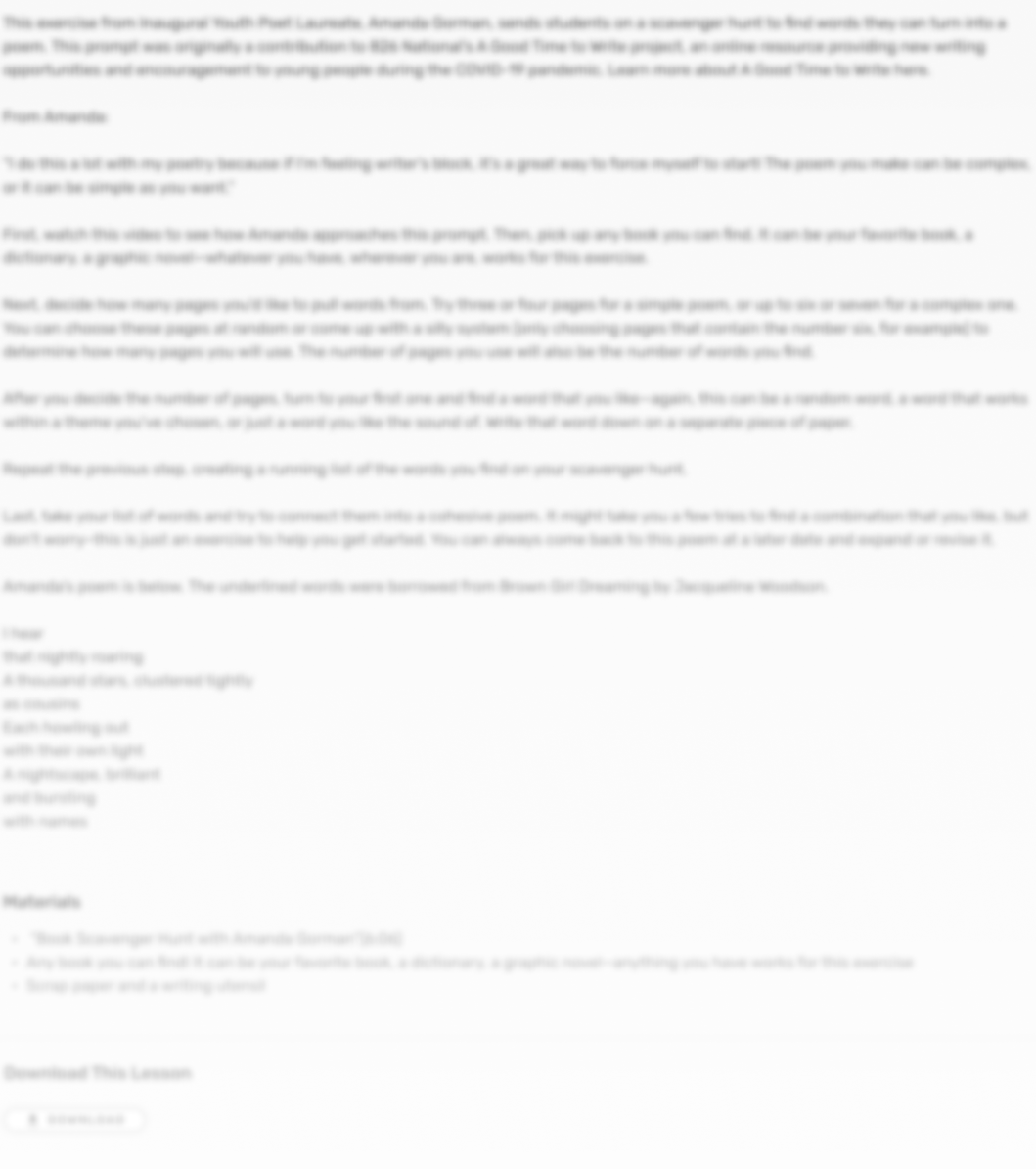 Grades 5–8
Grades 5–8 60 Minutes
60 Minutes Narrative
Narrative Videos
VideosMac Barnett is a New York Times best-selling author of books for children whose work has been awarded two Caledcott Honors, three E.B. White Read Aloud Awards, the Boston Globe-Horn Book Award, and has sold more than 4 million copies worldwide. His titles include The First Cat in Space Ate Pizza, Rules of the House, and Count the Monkeys.
Your students will learn the impact of a suspenseful cliffhanger and how to write one.
Students will produce a heightened, very short story that leaves readers on the edge of their seats—intentionally.
Author of books for children, Mac Barnett, demonstrates the impact of a strong cliffhanger ending. This prompt was originally a contribution to 826 National’s A Good Time to Write project, an online resource providing new writing opportunities and encouragement to young people during the COVID-19 pandemic. Learn more about A Good Time to Write here.
From Mac:
“If you don’t know how to end your story, don’t end it! Today, I want everyone to write a cliffhanger. Write as much suspense, as many exciting things, as wild a situation as you can—something that’s impossible to have your hero find their way out of—and then don’t worry about it. Create a massive problem—a huge, impossible-to-solve problem—and cut off the story at the moment of greatest suspense. That’s it.”
First, watch the video to see how Mac defines a cliffhanger. Did his definition surprise you at all?

by 826 National, featuring Nayeli Karunasekara, grade 6, Michigan
Through reading a Mentor Text, students learn more about the types of point of view and how different points of view impact their writing.
by 826 National
Novelist and short story writer, Caitlin Horrocks, reads "My Full Yard" by Marisol of 826michigan and reflects on the imagery used in the poem.
by 826 National, featuring Isaac Reynolds, Grade 6
What’s the moral of the story? In this lesson, students practice identifying and summarizing a moral in a fable written by a sixth grader.
by 826 National
Writer and 826michigan staffer, Eli Sparkman, shares stories about some of his favorite personal objects and encourages students to write down their own.
by 826 National
In this lesson, you will create a simple scrapbook that showcases the facts, definitions, and details you’ve learned about a few of the items you found in a scavenger hunt.
by 826 National
In this lesson, you will build your confidence as a writer by battling the page on a consistent basis.
by Javier Zamora, 826 Valenica alumni and New York Times bestselling author
Author Javier Zamora invites you to raise your voice and write to the next President of the United States.
by Emily Harding
Author and TV producer, Emily Harding shows side characters some love in this writing prompt.
by Jason Reynolds
National Ambassador for Young People's Literature and NYT Bestselling Author, Jason Reynolds, joined 826 students for a conversation on his video project, "For Every One."
by 826 National
In this lesson, you will learn a strategy for writing down your thoughts and feelings to understand them more clearly.
by 826 National
Misinformation Specialist with Google Nidhi Hebbar shares how you can use writing to inspire change and bring people into conversations about the issues you care about.
by 826 National, featuring Eloise Combs, Grade 3, Michigan
Not all poems have to rhyme, but when they do, they generally use “rhyme scheme.” In this lesson, students will write a poem with a unique sound and rhyme scheme.
by Daniel Handler
Author Daniel Handler, aka Lemony Snicket, shows there are no limits to imagination with this interviewing activity.
by Soeun Lee, Grade 8, Tenafly, New Jersey
In this poem, a student observes a dove's flight and reflects on their ability to soar.
by 826 National, featuring Milo Wu, Grade 2, NY
In this lesson, you will introduce an animal you know a lot about as the narrator of a story. The narrator will provide descriptive details ask the reader "Guess who?" at the end.
by 826 National
In this lesson, you will create a character and show how a character would respond in a specific situation by writing dialogue, resulting in a silly scene.
by 826 National, featuring Iman Abdullah, Grade 2, 826NYC
Have you ever thought about what you have in common with an animal? In this lesson, students will write a comparison poem that explores these similarities and differences.
by Cristeta Boarini, 826 MSP
Journalist and 826 MSP staffer, Cristeta Boarini, shares a poetry prompt that walks students through using shapes to convey meaning.
by Amanda Gorman
Presidential Inaugural Poet, activist, and bestselling author Amanda Gorman shares one of her favorite techniques for starting a poem or getting over writers' block.
by 826 National, featuring Priyanna Kumar Singhania, Grade 8
In this lesson, you will write down a story that’s been passed down to you, using precise words and phrases and sensory language, to convey a vivid picture of the event.
by Kinyel Friday, 826michigan
Children's book author, and 826michigan staff member, Kinyel Friday shares a social emotional learning prompt that uses personification to bring emotions to life.
by Amanda Dettmann, 826NYC
Poet and teaching artist with 826NYC, Amanda Dettmann, shares a simple and fun writing prompt that asks the question, "How Did You Get There?"
by 826 National, featuring Kaiden Griggs, Grade 6
In this lesson, students will identify the main idea and supporting details of an informational text and summarize this idea objectively.
by 826 National, featuring Naomi Ku, Grade 6, 826LA
What is the story of your favorite food? In this lesson, you will use descriptive details and sensory words to write a narrative that shares more about your favorite food.
by Cristeta Boarini, 826 MSP
Journalist and 826 MSP staffer, Cristeta Boarini, shares a poetry prompt that walks students through using shapes to convey meaning.
by Mychal Threets, librarian and literacy ambassador
Librarian and literacy ambassador Mychal Threets invites you to write about your feelings, your way with four writing prompts to explore your emotions on the page.
by Sarah Richman, 826DC
Writer and staffer at 826DC, Sarah Richman, shares an original writing prompt that will help you get aquainted with your new characters.
by 826 National, featuring Soeun Lee, Grade 8, NJ
In this lesson, you will create poems that look completely different from poems you have written before!
by 826 National
Author and illustrator Lisa Brown reads "Owl Girl. In this lesson, you will write a superhero story that introduces your character and establishes the context for your reader.
by 826 National
Author Carter Higgins reads "Pickup Lines Cheesier Than Cheddar," a piece written by fifth-grader Uma (826NYC).
by 826 National, featuring Raiya Chhabra, Grade 5, VA
In this lesson, you will generate rhymes to use in a poem.
by Molly Sprayregen, 826CHI
Writer and 826michigan staffer Denise Ervin writes alongside students to show what feelings sound like.
by 826 National
Author Tom Perrotta reads "Peter, Who Went on the Best Adventure Ever." In this lesson, you will learn about 3 shapes that will help the events of your story unfold naturally.
by 826 National
Award-winning documentarian and journalist,Soledad O'Brien, shares about why she loves her job and how she builds credibility out in the field through thorough research.
by Charlotte Yeung
Midwest Youth Poet Laureate Ambassador, Charlotte Yeung, shares one of her favorite brainstorming strategies for creating a new piece.


We are thrilled to have you as the newest member of our online community. Stay up-to-date on the the latest and most relevant resources, student publication opportunities, and what’s new with the 826 Digital community.
